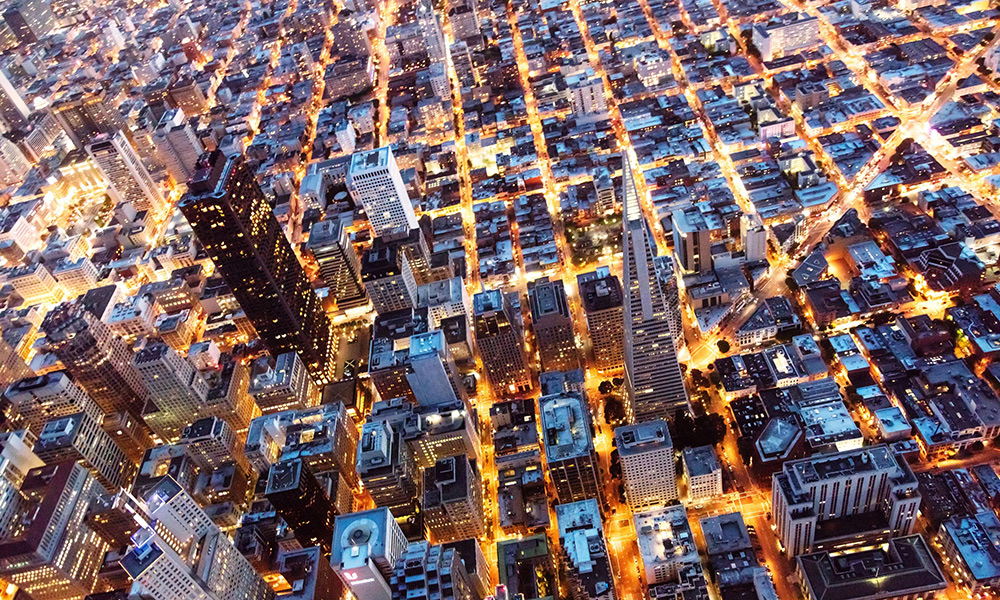
預(yù)計(jì)到2050年,,全球70%的人口將居住在城市,,這一龐大的數(shù)字使城市規(guī)劃更具挑戰(zhàn)性。因此,,規(guī)劃者尋求技術(shù)的幫助,,尤其是最近興起的生成式人工智能,以幫助設(shè)計(jì),、分析和開發(fā)那些擁擠不堪的地區(qū),。
技術(shù)狂熱者設(shè)想,城市規(guī)劃者可以運(yùn)用人工智能技術(shù)來研究開發(fā)提案,、分析擬議的分區(qū)變更,、制定全新的城市總體規(guī)劃或優(yōu)化現(xiàn)有規(guī)劃。
在最近的一個(gè)測(cè)試案例中,,弗吉尼亞理工大學(xué)(Virginia Tech)的教授們運(yùn)用生成式人工智能技術(shù)來確定一個(gè)地區(qū)的步行友好性,,方法是使用人工智能工具分析圖像中的建筑環(huán)境特征,如長(zhǎng)椅,、路燈和人行道,。如果人工智能能夠完成這些簡(jiǎn)單但勞動(dòng)密集型的任務(wù),城市規(guī)劃者或許就能騰出時(shí)間來解決城市面臨的更復(fù)雜的問題,,如經(jīng)濟(jì)適用房,、氣候變化和辦公行業(yè)的衰退。
將生成式人工智能整合到城市規(guī)劃數(shù)字化進(jìn)程中,,即所謂的“PlanTech”,,同樣面臨挑戰(zhàn),問題仍然存在:人工智能能否創(chuàng)造足夠的價(jià)值,,以證明其在城市規(guī)劃中的應(yīng)用是正當(dāng)?shù)模?/p>
無論是從經(jīng)濟(jì)還是環(huán)境角度來看,,人工智能基礎(chǔ)設(shè)施的建設(shè)和運(yùn)行成本高昂。如果生成式人工智能只能解決小問題,無法解決重大問題,,那么市政當(dāng)局可能會(huì)對(duì)這些投資的合理性提出質(zhì)疑,。此外,考慮到該領(lǐng)域在不平等方面漫長(zhǎng)而復(fù)雜的歷史,,城市規(guī)劃者可能會(huì)特別敏感,,擔(dān)心有偏見的訓(xùn)練數(shù)據(jù)會(huì)訓(xùn)練出有偏見的生成式人工智能模型。
以前的技術(shù)進(jìn)步是否對(duì)城市產(chǎn)生積極影響,?
盡管PlanTech帶來了顯著的效率提升,,但有時(shí)仍被視為“酷炫”卻華而不實(shí)的應(yīng)用。雖然這些應(yīng)用在某些方面改善了城市生活,,但卻無法解決實(shí)際問題,,如公共衛(wèi)生危機(jī)和日益飆升的住房成本。
21世紀(jì)初,,“智慧城市”概念的興起標(biāo)志著首次嘗試將尖端技術(shù)大規(guī)模融入現(xiàn)代城市規(guī)劃,。智慧城市通過運(yùn)用信息和通信技術(shù)(ICT),例如三維成像和信息建模,,來提升城市服務(wù)質(zhì)量,。以舊金山為例,該市實(shí)施了智能廢物管理系統(tǒng),,通過傳感器和聯(lián)網(wǎng)設(shè)備來優(yōu)化廢物的收集與處理流程,。
盡管智慧城市通過技術(shù)提升了效率,但目前尚不清楚這能否轉(zhuǎn)化為居民生活質(zhì)量的提升,。在疫情之后,,學(xué)者們期望了解最佳智慧城市是否在疫情遏制方面表現(xiàn)更為出色。他們考察了那些在環(huán)境,、流動(dòng)性,、城市規(guī)劃和交通等“智慧城市”指標(biāo)上排名靠前的城市,得出的結(jié)論是,,排名靠前的城市并不一定能更有效地應(yīng)對(duì)疫情。
還有人擔(dān)心,,智慧城市對(duì)建模和算法的關(guān)注可能會(huì)忽視城市生活中那些難以量化的方面,。
城市規(guī)劃領(lǐng)域最近一波技術(shù)革新涉及一種名為“數(shù)字孿生”的概念,它指的是城市區(qū)域的實(shí)時(shí)虛擬模型,,范圍從一棟建筑到整個(gè)城市,。與美國(guó)航空航天局(NASA)使用航天飛行數(shù)字模擬器來訓(xùn)練宇航員和任務(wù)控制人員類似,這些數(shù)字孿生模擬使得城市規(guī)劃者能夠在設(shè)計(jì)和土地使用計(jì)劃實(shí)施之前對(duì)其進(jìn)行測(cè)試,。
市政當(dāng)局能夠運(yùn)用數(shù)字孿生技術(shù),,探索自然災(zāi)害(例如百年一遇的洪水或極端高溫事件)的潛在影響,并據(jù)此制定應(yīng)對(duì)策略。借助數(shù)字孿生模型,,他們能夠針對(duì)新建建筑或區(qū)域進(jìn)行建模,,進(jìn)而在實(shí)際開發(fā)之前測(cè)試其在多種不同場(chǎng)景下的效果。
盡管數(shù)字孿生技術(shù)有望預(yù)測(cè)未來的挑戰(zhàn),,并助力規(guī)劃者制定出更具韌性的解決方案,,但在推廣數(shù)字孿生技術(shù)的過程中仍面臨一些障礙。其中最具挑戰(zhàn)性的是開發(fā)和維護(hù)這些模擬困難重重,。這些模擬往往需要大量數(shù)據(jù),,而數(shù)據(jù)來源廣泛,存儲(chǔ)格式不一定兼容,。
模擬的區(qū)域越大,、越復(fù)雜,整合所有必要數(shù)據(jù)的難度就越大,,更不必提及保持?jǐn)?shù)據(jù)持續(xù)更新了,。此外,與智慧城市一樣,,人們始終擔(dān)心并非所有城市景觀要素都可以量化并輸入模型,。
對(duì)人力資本的需求
隨著人工智能的進(jìn)步,預(yù)計(jì)城市規(guī)劃領(lǐng)域的先進(jìn)工具市場(chǎng)將會(huì)擴(kuò)大,。盡管這些技術(shù)能夠輔助城市規(guī)劃者,,但不太可能取代他們。
不要將城市規(guī)劃者與技術(shù)官僚混為一談,。城市規(guī)劃者的任務(wù)是改善城市居民的生活,,這要求他們采取多學(xué)科融合的方法論,不僅涉及土地使用決策制定的具體細(xì)節(jié),,還涵蓋社會(huì)科學(xué),、倫理道德和公共衛(wèi)生。展望未來,,規(guī)劃行業(yè)可能會(huì)面臨更多的技術(shù)變革,。為了確保相關(guān)性,規(guī)劃行業(yè)必須擁抱復(fù)雜性,,而非僅僅追求那些觸手可及的短期效率提升,。(財(cái)富中文網(wǎng))
本文為《財(cái)富》頭腦風(fēng)暴健康大會(huì)贊助商約翰斯·霍普金斯大學(xué)供稿。塞迪納·法爾(Seydina Fall)擔(dān)任該校凱瑞商學(xué)院房地產(chǎn)與基礎(chǔ)設(shè)施碩士項(xiàng)目學(xué)術(shù)主任,。
譯者:中慧言-王芳
預(yù)計(jì)到2050年,,全球70%的人口將居住在城市,這一龐大的數(shù)字使城市規(guī)劃更具挑戰(zhàn)性,。因此,,規(guī)劃者尋求技術(shù)的幫助,,尤其是最近興起的生成式人工智能,以幫助設(shè)計(jì),、分析和開發(fā)那些擁擠不堪的地區(qū),。
技術(shù)狂熱者設(shè)想,城市規(guī)劃者可以運(yùn)用人工智能技術(shù)來研究開發(fā)提案,、分析擬議的分區(qū)變更,、制定全新的城市總體規(guī)劃或優(yōu)化現(xiàn)有規(guī)劃。
在最近的一個(gè)測(cè)試案例中,,弗吉尼亞理工大學(xué)(Virginia Tech)的教授們運(yùn)用生成式人工智能技術(shù)來確定一個(gè)地區(qū)的步行友好性,,方法是使用人工智能工具分析圖像中的建筑環(huán)境特征,如長(zhǎng)椅,、路燈和人行道,。如果人工智能能夠完成這些簡(jiǎn)單但勞動(dòng)密集型的任務(wù),城市規(guī)劃者或許就能騰出時(shí)間來解決城市面臨的更復(fù)雜的問題,,如經(jīng)濟(jì)適用房,、氣候變化和辦公行業(yè)的衰退。
將生成式人工智能整合到城市規(guī)劃數(shù)字化進(jìn)程中,,即所謂的“PlanTech”,,同樣面臨挑戰(zhàn),問題仍然存在:人工智能能否創(chuàng)造足夠的價(jià)值,,以證明其在城市規(guī)劃中的應(yīng)用是正當(dāng)?shù)模?/p>
無論是從經(jīng)濟(jì)還是環(huán)境角度來看,,人工智能基礎(chǔ)設(shè)施的建設(shè)和運(yùn)行成本高昂。如果生成式人工智能只能解決小問題,,無法解決重大問題,,那么市政當(dāng)局可能會(huì)對(duì)這些投資的合理性提出質(zhì)疑。此外,,考慮到該領(lǐng)域在不平等方面漫長(zhǎng)而復(fù)雜的歷史,,城市規(guī)劃者可能會(huì)特別敏感,擔(dān)心有偏見的訓(xùn)練數(shù)據(jù)會(huì)訓(xùn)練出有偏見的生成式人工智能模型,。
以前的技術(shù)進(jìn)步是否對(duì)城市產(chǎn)生積極影響,?
盡管PlanTech帶來了顯著的效率提升,但有時(shí)仍被視為“酷炫”卻華而不實(shí)的應(yīng)用,。雖然這些應(yīng)用在某些方面改善了城市生活,,但卻無法解決實(shí)際問題,如公共衛(wèi)生危機(jī)和日益飆升的住房成本,。
21世紀(jì)初,“智慧城市”概念的興起標(biāo)志著首次嘗試將尖端技術(shù)大規(guī)模融入現(xiàn)代城市規(guī)劃,。智慧城市通過運(yùn)用信息和通信技術(shù)(ICT),,例如三維成像和信息建模,來提升城市服務(wù)質(zhì)量。以舊金山為例,,該市實(shí)施了智能廢物管理系統(tǒng),,通過傳感器和聯(lián)網(wǎng)設(shè)備來優(yōu)化廢物的收集與處理流程。
盡管智慧城市通過技術(shù)提升了效率,,但目前尚不清楚這能否轉(zhuǎn)化為居民生活質(zhì)量的提升,。在疫情之后,學(xué)者們期望了解最佳智慧城市是否在疫情遏制方面表現(xiàn)更為出色,。他們考察了那些在環(huán)境,、流動(dòng)性、城市規(guī)劃和交通等“智慧城市”指標(biāo)上排名靠前的城市,,得出的結(jié)論是,,排名靠前的城市并不一定能更有效地應(yīng)對(duì)疫情。
還有人擔(dān)心,,智慧城市對(duì)建模和算法的關(guān)注可能會(huì)忽視城市生活中那些難以量化的方面,。
城市規(guī)劃領(lǐng)域最近一波技術(shù)革新涉及一種名為“數(shù)字孿生”的概念,它指的是城市區(qū)域的實(shí)時(shí)虛擬模型,,范圍從一棟建筑到整個(gè)城市,。與美國(guó)航空航天局(NASA)使用航天飛行數(shù)字模擬器來訓(xùn)練宇航員和任務(wù)控制人員類似,這些數(shù)字孿生模擬使得城市規(guī)劃者能夠在設(shè)計(jì)和土地使用計(jì)劃實(shí)施之前對(duì)其進(jìn)行測(cè)試,。
市政當(dāng)局能夠運(yùn)用數(shù)字孿生技術(shù),,探索自然災(zāi)害(例如百年一遇的洪水或極端高溫事件)的潛在影響,并據(jù)此制定應(yīng)對(duì)策略,。借助數(shù)字孿生模型,,他們能夠針對(duì)新建建筑或區(qū)域進(jìn)行建模,進(jìn)而在實(shí)際開發(fā)之前測(cè)試其在多種不同場(chǎng)景下的效果,。
盡管數(shù)字孿生技術(shù)有望預(yù)測(cè)未來的挑戰(zhàn),,并助力規(guī)劃者制定出更具韌性的解決方案,但在推廣數(shù)字孿生技術(shù)的過程中仍面臨一些障礙,。其中最具挑戰(zhàn)性的是開發(fā)和維護(hù)這些模擬困難重重,。這些模擬往往需要大量數(shù)據(jù),而數(shù)據(jù)來源廣泛,,存儲(chǔ)格式不一定兼容,。
模擬的區(qū)域越大、越復(fù)雜,,整合所有必要數(shù)據(jù)的難度就越大,,更不必提及保持?jǐn)?shù)據(jù)持續(xù)更新了。此外,,與智慧城市一樣,,人們始終擔(dān)心并非所有城市景觀要素都可以量化并輸入模型,。
對(duì)人力資本的需求
隨著人工智能的進(jìn)步,預(yù)計(jì)城市規(guī)劃領(lǐng)域的先進(jìn)工具市場(chǎng)將會(huì)擴(kuò)大,。盡管這些技術(shù)能夠輔助城市規(guī)劃者,,但不太可能取代他們。
不要將城市規(guī)劃者與技術(shù)官僚混為一談,。城市規(guī)劃者的任務(wù)是改善城市居民的生活,,這要求他們采取多學(xué)科融合的方法論,不僅涉及土地使用決策制定的具體細(xì)節(jié),,還涵蓋社會(huì)科學(xué),、倫理道德和公共衛(wèi)生。展望未來,,規(guī)劃行業(yè)可能會(huì)面臨更多的技術(shù)變革,。為了確保相關(guān)性,規(guī)劃行業(yè)必須擁抱復(fù)雜性,,而非僅僅追求那些觸手可及的短期效率提升,。(財(cái)富中文網(wǎng))
本文為《財(cái)富》頭腦風(fēng)暴健康大會(huì)贊助商約翰斯·霍普金斯大學(xué)供稿。塞迪納·法爾(Seydina Fall)擔(dān)任該校凱瑞商學(xué)院房地產(chǎn)與基礎(chǔ)設(shè)施碩士項(xiàng)目學(xué)術(shù)主任,。
譯者:中慧言-王芳
Seventy percent of the world’s population will live in cities by 2050, and that huge number makes urban planning more challenging. As a result, planners have turned to technology, most recently generative AI, to help design, analyze, and develop overcrowded areas.
Enthusiasts envision urban planners using AI to review development proposals, analyze proposed zoning changes, and develop new city master plans or optimize existing ones.
In one recent test case, Virginia Tech professors used generative AI to determine the walkability of an area by using AI tools to analyze images for built environment features like benches, streetlights, and sidewalks. To the extent AI can take over such simple, but labor-intensive tasks, urban planners would perhaps have increased bandwidth to work on more complex problems facing cities—problems such as affordable housing, climate change, and the declining office sector.
The integration of generative AI into the digitalization of urban planning, also known as “PlanTech,” is not without its challenges, though, and the question remains: can AI offer enough value to justify its use?
The cost of building and running AI infrastructure is enormous, both in monetary and environmental terms. If generative AI can only solve the small problems, not the big ones, then municipalities may question whether these expenditures are worth it. Also, in light of their field’s long, tangled history when it comes to inequality, urban planners may be particularly sensitive to concerns about biased training data leading to biased generative AI models.
Have previous technological advancements improved cities?
Despite the tremendous efficiency gains PlanTech has achieved, it is sometimes perceived as part of a constellation of “cool” but gimmicky applications that improve certain aspects of urban life but fail to solve real problems, such as public health crises and burgeoning housing costs.
One of the first widespread attempts to integrate cutting-edge technologies into modern urban planning was the rise of “smart cities” in the early 2000s. Smart cities utilize information and communication technology (ICT), such as 3D imaging and information modeling, to improve the quality of urban services. San Francisco, for example, has implemented a smart waste management system that uses sensors and internet-connected devices to optimize the collection and disposal of waste.
While smart cities’ use of technology has led to efficiency gains, it is unclear that this translates into an improved quality of life for their citizens. After the COVID-19 pandemic, academics wanted to find out if the smartest cities performed better in managing the pandemic. They looked at municipalities that ranked high on “smart city” indicators such as the environment, mobility, urban planning, and transportation, and concluded that the highest ranked cities did not necessarily manage the pandemic better.
There are also concerns that the focus of smart cities on modeling and algorithms may disadvantage those aspects of urban life that are not easy to measure quantitatively.
A more recent wave of technological innovation in urban planning involves a concept called “digital twins,” which are real-time virtual models of urban areas, ranging from a building to an entire city. Much like how NASA uses digital spacecraft simulators to train astronauts and mission control crews, these digital twin simulations allow urban planners test their designs and land use plans before they are implemented.
Municipalities can use digital twins to explore the impact of natural disasters, like a 100-year flood or extreme heat events, and develop a response. Using a digital twin, it is possible to model new buildings or regions and test them under many different scenarios before the actual development is built.
While digital twins hold the promise of predicting future challenges and enabling planners to develop resilient solutions, some obstacles stand in the way of widespread adoption. Among the most challenging is the difficulty of developing and maintaining a digital twin simulation. These simulations often require a vast amount of data, which is drawn from a wide range of sources and stored in formats that are not necessarily compatible.
The larger and more complex the region being simulated, the more challenging it is to integrate all of the necessary data, much less keep it up-to-date. In addition, as with smart cities, there is always the concern that not all facets of the urban landscape can be quantified and plugged into a model.
The need for human capital
The market for advanced technological tools for urban planning is expected to grow, as it has with the development of AI. While these technologies may assist urban planners, they are unlikely to replace them.
Urban planners are not be confused with technocrats. Planners are tasked with improving the lives of city dwellers, which requires a multidisciplinary approach that encompasses not only the nuts and bolts of making land use decisions, but also social sciences, ethics, and public health. The planning profession is likely to face more technological disruptions in the future. To stay relevant, it needs to embrace complexity and not settle for low hanging short-term efficiency gains.
This commentary is from Johns Hopkins University, a sponsor of Fortune Brainstorm Health. Seydina Fall is the academic program director of the MS in Real Estate and Infrastructure program at Johns Hopkins Carey Business School.






